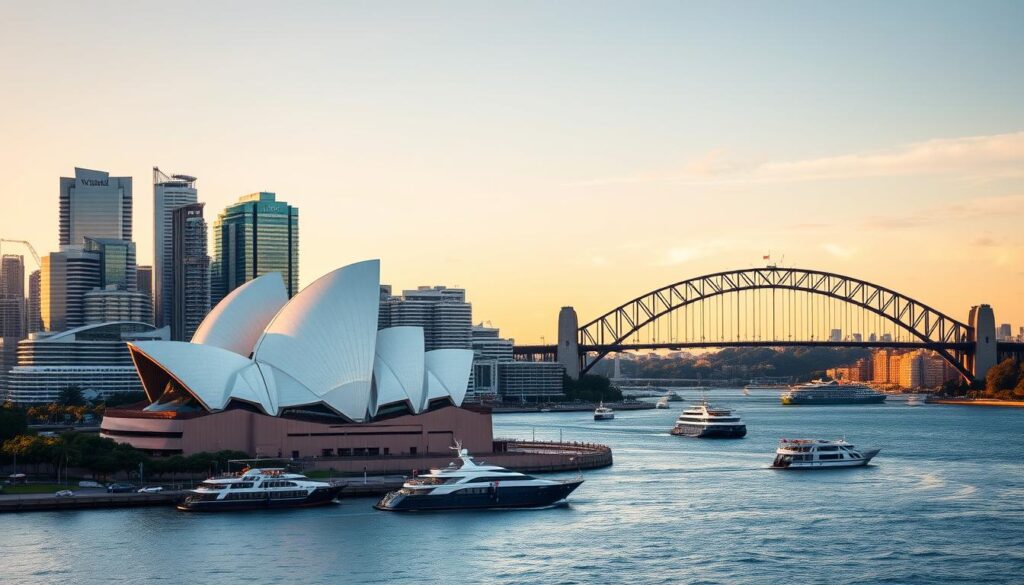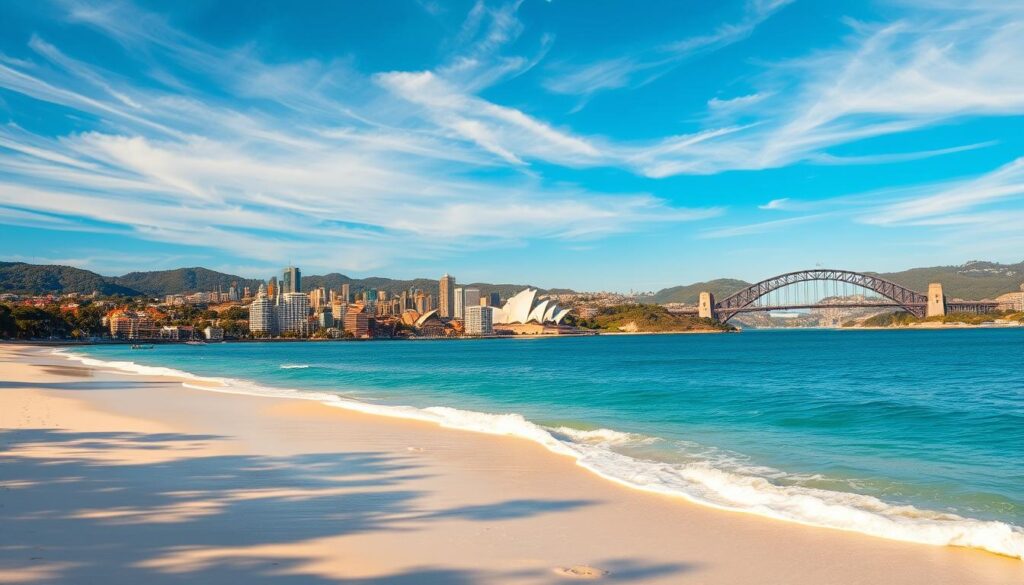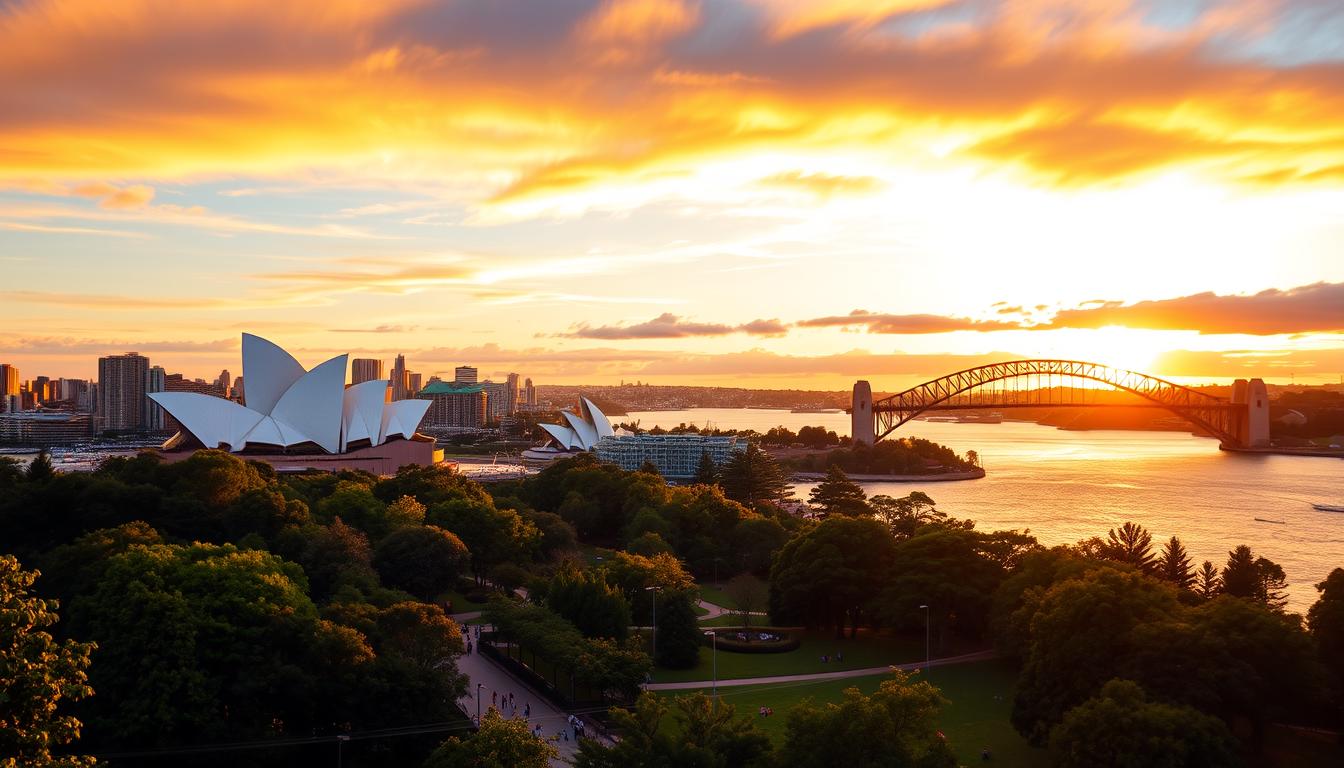Table of Contents
ToggleSydney, Australia’s most vibrant city, is known for its iconic landmarks, stunning beaches, and rich cultural attractions. Whether you’re drawn to the Opera House, Bondi Beach, or the bustling Darling Harbour, this city offers something for everyone. Let’s discover the best time to visit Sydney in Australia and plan your trip with our comprehensive guide, covering weather, events, and tourist season.
For those planning a trip, the ideal periods are September to November (spring) and March to May (autumn). These months provide pleasant weather, fewer crowds, and a chance to enjoy outdoor activities comfortably. Let’s know the best time to visit Sydney Australia.
When deciding when to go, consider factors like your weather preferences, budget, and tolerance for crowds. Seasonal festivals, whale watching opportunities, and temperature variations also play a role in shaping your experience.
This guide aims to help you balance these priorities, ensuring a tailored and memorable Sydney adventure.
Introduction to Sydney
Sydney, a coastal gem, blends urban energy with natural beauty. Nestled along the Pacific Ocean, this city is famous for its stunning harbour, golden beaches, and iconic landmarks. Whether you’re exploring the bustling streets or relaxing by the sea, Sydney offers a unique mix of experiences.
Geographically, Sydney is a paradise. The Harbour Bridge and Opera House dominate the skyline, while Bondi Beach draws surfers and sunbathers. Just a short drive away, the Blue Mountains provide a serene escape with breathtaking views. This diversity makes the city a perfect destination for all types of travellers.

Culturally, Sydney is a melting pot. Its food scene reflects global influences, from Asian street food to European fine dining. Art lovers can explore the Art Gallery of NSW, while history buffs will enjoy The Rocks, a historic area with cobblestone streets and colonial architecture.
Outdoor activities are a highlight here. Coastal walks, such as the Bondi to Coogee trail, offer stunning ocean views. Sydney Harbour ferries provide a relaxing way to see the city from the water. Whether it’s summer or winter, there’s always something to do under the sunshine.
However, planning a trip can be challenging. Balancing weather, crowds, and seasonal events requires careful consideration. For example, summer brings warm days but also larger crowds. Understanding these factors ensures a smoother experience.
| Urban Attractions | Beachside Attractions |
|---|---|
| Sydney Opera House | Bondi Beach |
| Art Gallery of NSW | Coastal Walks |
| The Rocks | Harbour Ferries |
Understanding Sydney’s Climate
Sydney’s climate is as diverse as its attractions, offering something for every traveller. With a temperate climate, the city enjoys mild winters, warm summers, and moderate rainfall throughout the year. This makes it a versatile destination for outdoor activities and sightseeing.

Seasonal Weather Patterns
Summers in Sydney are warm, with temperatures averaging between 18°C and 28°C. December to February is the peak of the season, with occasional highs reaching 40°C. Winters, from June to August, are mild, with lows of 9°C and highs of 19°C. This makes it comfortable for exploring the city without extreme cold.
March is known for its high humidity, while June is the wettest month, with an average rainfall of 142mm. Understanding these patterns helps you plan your trip better, ensuring you’re prepared for the weather.
Best Months for Comfortable Weather
Transitional seasons, like spring (September to November) and autumn (March to May), offer the most stable weather. During these months, temperatures range between 12°C and 26°C, making it ideal for outdoor activities. These periods also see fewer rainy days, allowing you to explore the city comfortably.
Microclimates add another layer to Sydney’s climate. Coastal areas benefit from refreshing breezes, while western suburbs experience higher temperatures. This diversity ensures there’s always a spot to suit your preferences, no matter the season.
Best Time to Visit Sydney in Australia for Weather
If you want to visit Sydney, you need to remember that Sydney’s weather patterns play a key role in planning your trip. Each season offers distinct advantages, making it essential to choose the right month for your visit. Whether you prefer sunny days or cooler temperatures, understanding the city’s climate ensures a comfortable experience.
Spring, from September to November, is ideal for outdoor exploration. With temperatures ranging between 12°C and 24°C, this season provides dry, sunny days and minimal rain. It’s perfect for coastal walks, harbour cruises, and exploring the city’s parks.
Autumn, from March to May, offers warmer ocean temperatures but comes with a higher risk of rain. If you’re planning beach activities, this season is a great choice. However, packing an umbrella is advisable to stay prepared for occasional showers.
Summer, from December to February, is synonymous with beach weather. While the temperatures can soar up to 40°C, the humidity and crowds might be challenging. If you enjoy vibrant energy and long days of sunshine, this is the season for you.
Winter, from June to August, is mild and crisp, with temperatures averaging 9°C to 19°C. This season is ideal for indoor activities like visiting museums or whale watching. It’s also a quieter time, with fewer tourists around.
Here’s a quick comparison of Sydney’s seasons:
| Season | Weather | Activities |
|---|---|---|
| Spring (Sept-Nov) | Dry, sunny | Outdoor exploration |
| Autumn (March-May) | Warm, occasional rain | Beach activities |
| Summer (Dec-Feb) | Hot, humid | Beach days, festivals |
| Winter (June-Aug) | Mild, crisp | Indoor attractions |
Packing tips vary by season. For spring and autumn, bring layers to adapt to changing temperatures. In summer, sunscreen and light clothing are essential. For winter, a jacket and an umbrella will keep you comfortable during cooler days.
Best Time to Visit Sydney for Crowds and Prices
Sydney’s popularity means navigating busy periods and higher prices during peak times. Understanding the city’s tourist seasons can help you plan a more enjoyable and affordable trip. Whether you prefer bustling energy or quieter days, timing your visit is key.
Peak Tourist Season
December to January is Sydney’s peak tourist season. During this period, hotel rates can spike by 30%, and popular spots like Bondi Beach are packed. Restaurants and attractions often require bookings weeks in advance, making spontaneity challenging.
This season coincides with summer holidays, drawing both international visitors and locals. While the vibrant atmosphere is exciting, the combination of high prices and large crowds can be overwhelming for some travellers.
Off-Season Benefits
June to August, Sydney’s winter months, offer a quieter and more affordable experience. Flights and accommodation are cheaper, and attractions like the Opera House and museums are less crowded. Harbour cruises often have discounted rates, making it a great time to explore the city from the water.
Winter also avoids the chaos of school holidays, providing a more relaxed atmosphere for families. Mid-year travel allows you to enjoy Sydney’s indoor attractions without the hustle and bustle of peak periods.
For those seeking a balance, shoulder seasons like March to May and September to November are ideal. These months feature moderate pricing, manageable crowds, and pleasant weather, making them perfect for outdoor activities and sightseeing.
Here are some tips to make the most of your visit:
- Book popular tours, such as Opera House visits, at least three months ahead during peak season.
- Consider travelling in winter for discounted rates and fewer tourists.
- Plan around school holidays to avoid the busiest days.
Best Time to Visit Sydney for Activities
Sydney’s diverse range of activities ensures there’s something for every traveller, no matter the season. From coastal walks to cultural landmarks, the city offers endless opportunities to explore. Whether you’re planning outdoor activities or indoor attractions, timing your visit can enhance your experience.
Outdoor Adventures
For those who love the sunshine, summer is perfect for swimming at Bondi Beach or soaking up the vibrant atmosphere. Spring and autumn are ideal for walks along the Bondi to Coogee trail or hiking in the Blue Mountains. These seasons offer mild weather and stunning views.
Winter brings unique outdoor activities like whale-watching cruises. May to August is the best period to spot humpback whales. For adventure seekers, a ski trip to Thredbo is a great way to enjoy the colder days.
Indoor Attractions
Rainy days don’t have to dampen your plans. Sydney’s indoor attractions, like the Powerhouse Museum and Queen Victoria Building, offer plenty of things to do. The Sydney Tower Eye provides panoramic views of the city, even on overcast days.
For a unique experience, consider ghost tours at Q Station or join a winter swim club at Bronte Pool. These hidden gems add a special touch to your trip, especially during the cooler months.
Here are some tips to make the most of your visit:
- Book whale-watching tours early in May for the best sightings.
- Plan coastal walks during spring or autumn for comfortable weather.
- Explore indoor attractions on rainy days to stay dry and entertained.
Best Time to Visit Sydney for Festivals and Events
Sydney’s calendar is packed with vibrant festivals and events throughout the year. From dazzling light shows to cultural parades, there’s always something happening to captivate visitors.
One of the most iconic events is the New Year’s Eve fireworks. This spectacular display attracts millions, but it comes with challenges. Accommodation prices often triple, and bookings need to be made 6 to 12 months in advance.
For a more relaxed experience, consider Vivid Sydney in June. This festival transforms the city into a canvas of light installations. Many of these displays are free, making it a budget-friendly option for families and solo travellers alike.
March brings the colourful Mardi Gras parade, a celebration of diversity and inclusion. With over 500,000 attendees, public transport is the best way to navigate the city during this time.
Other annual highlights include the Sydney Festival in January, Sculpture by the Sea in October and November, and the City2Surf run in August. Each offers unique things to do and see, ensuring there’s something for everyone.
Winter also has its charm, with the Bondi Festival featuring ice rinks and night markets. This season contrasts with the busy summer events, offering a quieter yet equally enjoyable experience.
Here are some tips for planning your trip around Sydney’s festivals:
- Book accommodation early for New Year’s Eve to avoid high prices.
- Use public transport during Mardi Gras to navigate the crowds easily.
- Explore free installations at Vivid Sydney for a budget-friendly experience.
Worst Time to Visit Sydney
While Sydney is a year-round destination, certain periods can be challenging for travellers. December to January, the peak of summer, brings intense heatwaves with temperatures soaring up to 40°C. The humidity can make outdoor activities uncomfortable, and popular spots like Bondi Beach are packed with crowds.
Restaurants often have wait times of up to two hours, and accommodation prices skyrocket. For example, a night at a Darling Harbour hotel can cost $400, compared to $220 in August. This season coincides with school holidays, making it even busier.
June, the wettest month, is another challenging period. Frequent rain can disrupt outdoor plans, making it difficult to enjoy coastal walks or harbour cruises. If you’re visiting during this time, consider indoor attractions or nearby escapes like Hunter Valley or the Southern Highlands.
For those determined to visit during these periods, here are some tips:
- Visit beaches at dawn to avoid the midday heat and crowds.
- Use CBD ferries to navigate the city and skip traffic.
- Book accommodations and dining reservations well in advance.
By planning ahead and adjusting your schedule, you can still enjoy Sydney even during its most challenging months.
Conclusion
Planning a memorable trip involves balancing weather, activities, and seasonal events. Shoulder seasons like spring and autumn offer a perfect mix of pleasant conditions and fewer crowds. We tried to give you enough information about the best time to visit Sydney, Australia. Winter provides budget-friendly options, while summer is ideal for vibrant festivals and beach days.
Adjust your travel style to match your priorities. Families may prefer quieter months, while adventure seekers can target whale-watching or hiking opportunities. Use this guide to tailor your experience, whether you’re chasing events or seeking savings.
For a unique experience, consider late November when Kirribilli’s jacaranda trees bloom. Check flight deals for May or September to make the most of your journey. Sydney’s year-round appeal ensures there’s always something to explore, no matter the season.
FAQs on Best Time to Visit Sydney
What is Sydney’s climate like throughout the year?
Sydney enjoys a temperate climate with warm summers and mild winters. Summers (December to February) are hot and humid, while winters (June to August) are cooler and drier. Spring and autumn offer pleasant temperatures and moderate rainfall.
When is the ideal period for comfortable weather in Sydney?
March to May (autumn) and September to November (spring) are ideal for comfortable weather. These months feature mild temperatures, lower humidity, and fewer rainy days, making outdoor activities enjoyable.
When is the peak tourist season in Sydney?
The peak season runs from December to February, coinciding with summer holidays and major events like New Year’s Eve. Expect larger crowds, higher prices, and bustling beaches during this period.
Are there benefits to visiting Sydney during the off-season?
Yes, visiting from June to August (winter) offers benefits like fewer crowds, cheaper flights, and discounted accommodation. While cooler, it’s still a great time to explore indoor attractions and enjoy the city’s charm.
What are the best activities to do in Sydney during summer?
Summer is perfect for outdoor adventures like swimming at Bondi Beach, hiking in the Blue Mountains, or taking scenic walks across the Harbour Bridge. The long daylight hours and warm weather make it ideal for exploring.
Are there any major festivals or events in Sydney?
Sydney hosts numerous events year-round, including the iconic New Year’s Eve fireworks, Vivid Sydney in May-June, and the Sydney Festival in January. These events attract visitors from around the globe.
When is the least favourable time to visit Sydney?
January and February can be less favourable due to high humidity, occasional heatwaves, and crowded tourist spots. If you prefer milder weather and fewer people, consider visiting during the shoulder seasons.
What should I pack for a trip to Sydney?
Pack light clothing, sunscreen, and a hat for summer. Bring a light jacket for cooler evenings in spring and autumn. For winter, pack warmer layers, especially if you plan to explore early mornings or evenings.
Another Article: Best Time of Year to Visit Perth

